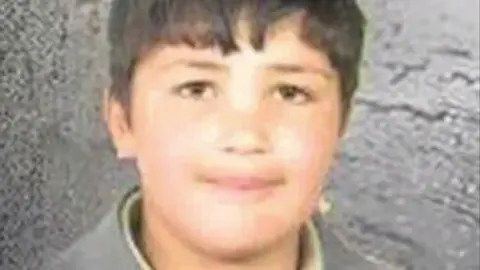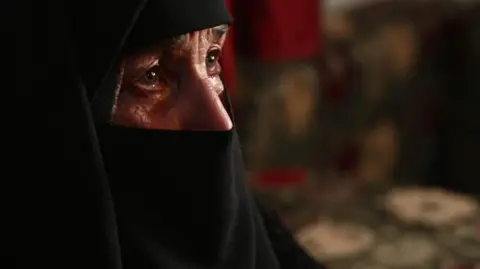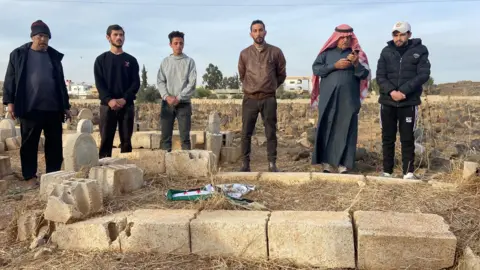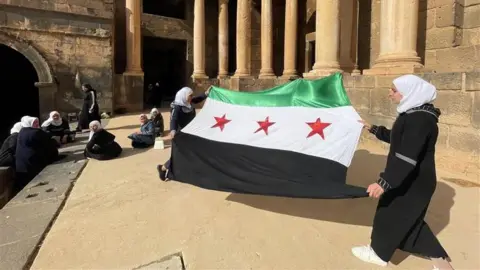Mother whose son’s death inflamed Syrian revolution on Assad’s downfall
 BBC
BBCIf the push to oust Bashar al-Assad was born anywhere, it was born in Deraa, a small city in Syria near the Jordanian border.
Here, on 21 May 2011, the tortured and mutilated body of 13-year-old Hamza al-Khatib was delivered to his family weeks after his arrest at an anti-government rally.
His death, and the torture of other local teenagers for writing anti-Assad graffiti, sparked widespread protests and a harsh crackdown by government forces.
If anyone in Deraa should be celebrating the fall of Assad’s regime, it’s the Khatib family.
But when we visited today, no one in that house was celebrating.
They had just been sent screenshots of documents found in the notorious Saydnaya prison confirming that Hamza’s older brother Omar – also arrested by the police in 2019 – had died in custody.
The boys’ mother, Samira, shaking with grief, told me she had been waiting for Omar to emerge from prison.
“I was thinking maybe he’ll come today or tomorrow,” she said. “Today, I got the news.”

Dressed all in black, and already mourning her husband, who died less than three months ago, she asked for former President Bashar al-Assad himself to experience what she had lived through.
“I hope he will pay the price,” she said. “And that God will take revenge on him, and on his children.”
Her nephew, Hossam al-Khatib, said the documents had been published on social media, by people scouring Saydnaya for information on their relatives. They found Omar’s file and shared it online, knowing that he was Hamza’s brother.
The fall of Assad has lifted the lid on decades of repression in Syria, and much of Deraa was out on the streets on Sunday, giddy with freedom, as rebel fighters took the capital Damascus and Assad fled.
Mobile phone footage shows crowds of men running around Deraa’s central square in a chaotic outpouring of joy – shouting and firing weapons into the air.
This area was a key opposition heartland during the Assad regime – heavy battles are etched onto schools and homes here, village after village corroded by tank rounds and machine gun fire.
The opposition in this southern part of Syria is different to the alliance led by Islamist militant group Hayat Tahrir al-Sham (HTS), which swept down from the north and took the capital last week. But they both converged on the capital on Sunday.
The Free Syria Army (FSA) began fighting here in 2011, when the harsh government crackdowns following Hamza’s death convinced some serving officers in Assad’s army to defect and form a rebel force.

One of them was Ahmed al-Awda, a poet who studied English literature at university before becoming an army officer, and then a rebel leader – now the militia leader of Deraa Province.
“You can’t imagine how happy we are,” he told me in the nearby town of Busra. “We have been crying for days. You can’t imagine what we feel. Everyone here in Syria lost family. Everyone was suffering.”
Mr Awda said he was among the first to enter Damascus on Sunday, along with HTS. The first thing he did, he added, was to go to the embassies and government buildings, to protect the people inside.
“We took many of the civilian government guys to the Four Seasons hotel, and put a very big force there to protect them,” he said.
“You know it will be a mad time, so I did my best to protect everybody there, even the government guys. I don’t want to punish them, they are Syrian.”
But he says he won’t forgive Assad so easily.
“I will do my best to bring him to judgement in court, to take his punishment, because we will not forget what he did to the Syrian people, and how he destroyed Syria.”
Assad’s departure has bestowed a fragile unity on Syria and its diverse opposition forces. But they no longer have a common enemy, and with outside powers still invested here, their differences could come under strain.
There are concerns that Syria could follow the path of Iraq and Libya and splinter into chaos.
“We saw what happened in Iraq and we refuse it,” Mr Awda said.
Assad’s forces weren’t the only ones he was fighting here over the past few years. Islamic State (IS) group cells – still scattered across the east of the country – were also a threat.

Mr Awda says he fought against them, killing a senior IS leader, Abu Ibrahim al-Qurayshi, two years ago.
Now Assad’s powerful backers, Iran and Russia, are no longer acting as a brake on IS, many here are worried about a resurgence.
Mr Awda is adamant this won’t happen. “No,” he insisted. “I kicked them out. We didn’t push Assad out only to live under IS.”
Now he wants free elections, believing that the Syrian people will never again choose anyone who would become a dictator.
In Deraa’s cemetery, the plaque on Hamza’s grave lies in pieces – broken by a government tank shell during fighting with rebel forces here, the family said.
“They kept hitting him even when he was dead,” one cousin remarked.
Neighbours watched in silence as the Syrian opposition flag was tied around Hamza’s headstone.
Behind it, the graves tell a story of 13 years of fighting: an air strike, a battle, a whole family killed in their home.
The war with Assad has ended – but peace in Syria has not yet been won.




